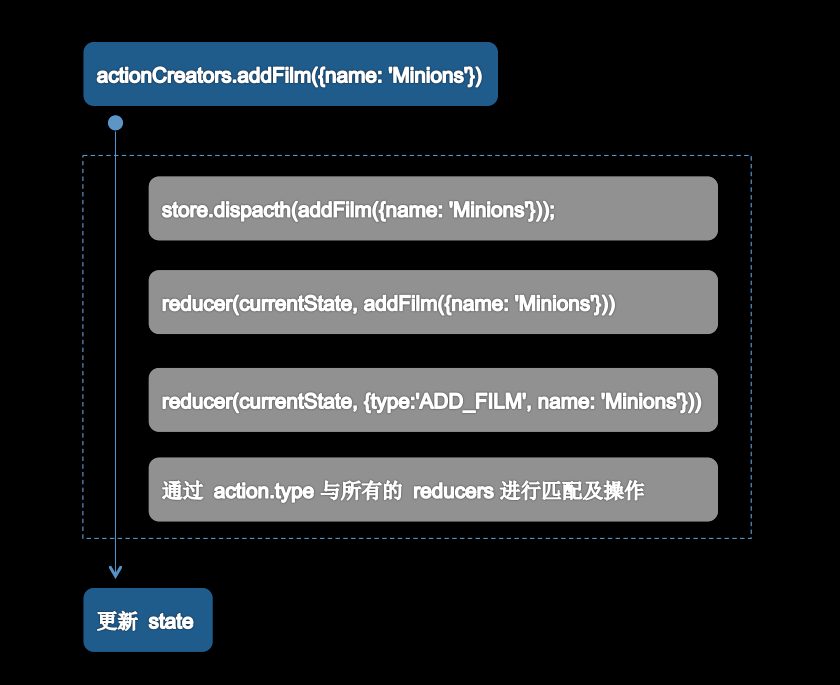原文地址
继 Facebook 提出 Flux 架构来管理 React 数据流后,相关架构开始百花齐放,本文简单分析 React 中管理数据流的方式,以及对 Redux 进行较为仔细的介绍。
React
" A JAVASCRIPT LIBRARY FOR BUILDING USER INTERFACES "
在 React 中,UI 以组件的形式来搭建,组件之间可以嵌套组合。另,React 中组件间通信的数据流是单向的,顶层组件可以通过 props 属性向下层组件传递数据,而下层组件不能向上层组件传递数据,兄弟组件之间同样不能。这样简单的单向数据流支撑起了 React 中的数据可控性。
那么,更全面的组件间通信形式该怎么实现呢?
-
嵌套组件间,上层组件向下层组件传递回调函数,下层组件触发回调来更新上层组件的数据。
-
以事件的形式,使用发布订阅的方式来通知数据更新。
-
Flux ---- Fackbook 提出的管理 React 数据流的架构。Flux 不像一个框架,更是一种组织代码的推荐思想。就像 “ 引导数据流流向的导流管”。
-
其他的 “ 导流管”。ReFlux,Redux 等。
前两种形式其实也足够在小应用中跑起来。但当项目越来越大的时候,管理数据的事件或回调函数将越来越多,也将越来越不好管理了。 对于后两种形式,个人经过对比后,可以看出 Redux 对 Flux 架构的一些简化。如 Redux 限定一个应用中只能有单一的 store,这样的限定能够让应用中数据结果集中化,提高可控性。当然,不仅如此。
Redux
Redux 主要分为三个部分 Action、Reducer、及 Store
Action
在 Redux 中,action 主要用来传递操作 State 的信息,以 Javascript Plain Object 的形式存在,如
在上面的 Plain Object 中,type 属性是必要的,除了 type 字段外,action 对象的结构完全取决于你,建议尽可能简单。type 一般用来表达处理 state 数据的方式。如上面的 'ADD_FILM' 表达要增加一个电影。而 name 表达了增加这个电影的电影名为 'Mission: Impossible'。那么,当我们需要表达增加另一部电影时,就需要另外一个 action,如
上面写法没有任何问题,但细想,当我们增加的电影越来越多的时候,那这种直接声明的 Plain Object 将越来越多,不好组织。实际上,我们可以通过创建函数来生产 action,这类函数统称为 Action Creator,如
这样,通过调用 addFilm(name) 就可以得到对应的 Action,非常直接。
Reducer
有了 Action 来传达需要操作的信息,那么就需要有根据这个信息来做对应操作的方法,这就是 Reducer。 Reducer 一般为简单的处理函数,通过传入旧的 state 和指示操作的 action 来更新 state,如
上面代码展示了 Reducer 根据传入的 action.type 来匹配 case 进行不同的 state 更新。
显然,当项目中存在越来越多的 action.type 时,上面的 films 函数(Reducer)将变得越来越大,越来越多的 case 将导致代码不够清晰。所以在代码组织上,通常会将 Reducer 拆分成一个个小的 reducer,每个 reducer 分别处理 state 中的一部分数据,最终将处理后的数据合并成为整个 state。
在上面的代码中,我们可以把 'ADD_FILM' 和 'DELETE_FILM' 归为操作 state.films 的类,而 'SHOW_ALL_FILM' 为过滤显示类,所以可以把大的 film Reducer 拆分成 filmReducer 和 filterReducer,如
1 filmReducer
2 filterReducer
最后,通过组合函数将上面两个 reducers 组合起来,如
上面的 rootReducer 将不同部分的 state 传给对应的 reducer 处理,最终合并所有 reducer 的返回值,组成整个 state。
实际上,Redux 提供了 combineReducers() 方法来做 rootReducer 所做的事情。使用 combineReducers 来重构 rootReducer,如
combineReducers() 将调用一系列 reducer,并根据对应的 key 来筛选出 state 中的一部分数据给相应的 reducer,这样也意味着每一个小的 reducer 将只能处理 state 的一部分数据,如:filterReducer 将只能处理及返回 state.filter 的数据,如果需要使用到其他 state 数据,那还是需要为这类 reducer 传入整个 state。
在 Redux 中,一个 action 可以触发多个 reducer,一个 reducer 中也可以包含多种 action.type 的处理。属于多对多的关系。
Store
回顾 Action 及 Reducer:
Action 用来表达操作消息,Reducer 根据 Action 来更新 State。
在 Redux 项目中,Store 是单一的。维护着一个全局的 State,并且根据 Action 来进行事件分发处理 State。可以看出 Store 是一个把 Action 和 Reducer 结合起来的对象。
Redux 提供了 createStore() 方法来 生产 Store,并提供三个 API,如
store 对象可以简单的理解为如下形式
store.getState() 用来获取 state 数据。
store.subscribe(listener) 用于注册监听函数。每当 state 数据更新时,将会触发监听函数。
而 store.dispatch(action) 是用于将一个 action 对象发送给 reducer 进行处理。如
store 对象使得我们可以通过 store.dispatch(action) 来减少对 reducer 的直接调用,并且能够更好地对 state 进行统一管理。没有 store,可能会出现 reducer(currentState, action) 这样的频繁地传入 state 参数的更新形式。
bindActionCreators
从上面的 Action 相关介绍中可知,我们使用了 ActionCreator 来生产 action。所以在实际的 store.dispatch(action) 中,我们需要这样调用 store.dispatch(actionCreator(...args))。
借鉴 Store 对 reducer 的封装(减少传入 state 参数)。可以对 store.dispatch 进行再一层封装,将多参数转化为单参数的形式。 Redux 提供的 bindActionCreators 就做了这件事。如
现在,经 bindActionCreators 包装过后的 action Creator 形成了具有改变全局 state 数据的多个函数,将这些函数分发到各个地方,即能通过调用这些函数来改变全局的 state。
Redux 中的函数传递及原理
当调用了具备操作全局 state 的函数时,将经过一系列的函数传递及调用,如
问:为什么不直接使用 reducer(currentState, {type:'ADD_FILM', name: 'Minions'})) 呢?
答:这样做除了在代码组织和扩展维护上提供了便利,同时也涵盖了函数式编程的许多优点。
React-Redux
Redux 并不依赖于 React,它支持多种框架 Ember、Angular、jQuery 甚至纯 JavaScript。但实际上,它更合适由 数据更新 UI 的框架。如 React、Deku。
上面的章节最终通过 bindActionCreators 得到具有操作全局 state 的函数集合,在与 React 搭配时,就会将这些函数分发到各个对应的组件中,从而组件具备了操作全局的 state 的功能。在上节中可以得到,调用操作全局 state 的函数,最终将更新 state。当 redux 与 react 结合,在更新 state 时,将会触发 重新渲染 组件的函数,进而组件得到更新。
react-redux 主要提供两个组件来实现上述功能。
Connect
Connect 组件主要为 React 组件提供 store 中的部分 state 数据 及 dispatch 方法,这样 React 组件就可以通过 dispatch 来更新全局 state。在 React 组件中,如果你希望让组件通过调用函数来更新 state,可以通过使用 const actions = bindActionCreators(FilmActions, dispatch); 将 actions 和 dispatch 揉在一起,成为具备操作 store.state 的 actions。最终将 actions 和 state(state.films)以 props 形式传入子组件中。如
由上,在 redux 提供的 connect 函数中,select 函数用于筛选 state 的部分数据,最终和 dispatch 以 props 的形式传给 React 组件(FilmApp)。FilmApp 就可通过 this.props 来得到 store 中的 state 及 dispatch。
在 redux 中,没有与 redux 有直接关联的组件称为木偶组件,如 FilmApp 下的子组件,不理外面纷纷扰扰,只知道自己拥有了 state 及 具备操作 state 数据的 actions 方法。
当木偶组件使用 actions 方法,更新了 store.state 的数据时,将会触发 store 中的 subscribe 所注册的函数。而其中一个注册函数,就在 Connect 组件中静默注册了。
即当 actions 更改了 state 时,会调用注册函数 handleChange。从而进行 “ 阿米诺骨牌式” 的函数执行连锁反应。更新了 state,并使用新的数据重新 render 组件。实际上是为智能组件 FilmApp(传入 connect 的组件)传入新的 props,因为各个子元素是通过引用父级组件的 props,所以将进行一级一级的差异数据更新,最终效果就是页面更新了。
实际上,这里与简单的发布订阅模式类似。使用 store.subscribe(cb); 来订阅一个回调函数,子组件进行 action 操作 store.state 时进行发布,执行了回调函数。
在 react-redux 中,数据的流向及对应的反应,如
Provider
Connect 组件需要 store。这个需求由 Redux 提供的另一个组件 Provider 来提供。源码中,Provider 继承了 React.Component,所以可以以 React 组件的形式来为 Provider 注入 store,从而使得其子组件能够在上下文中得到 store 对象。如
在 React 0.13 及以前的版本中,Provider 渲染子组件是通过执行 children(),如
所以在 React 0.13 及以前的版本中,Provider 的子组件必须是一个函数。这个问题在 React 0.14 中修复。
更多
编辑状态的实时预览 redux-dev-tools https://github.com/gaearon/redux-devtools
大量的相关参考 awesome-redux https://github.com/xgrommx/awesome-redux






React Native初探 — 好JSER 2016 年 11 月 10 日
[…] React 数据流管理架构之 Redux 介绍 http://www.alloyteam.com/2015/09/react-redux/ […]
基于 React.js + Redux + Bootstrap 的 Ruby China 示例-zoues 2016 年 10 月 25 日
[…] 介绍: < http://www.alloyteam.com/2015/09/react-redux […]
基于 React.js + Redux + Bootstrap 的 Ruby China 示例-鲸鱼云 2016 年 10 月 22 日
[…] Redux 介绍: <http://www.alloyteam.com/2015/09/react-redux/> […]
Tintin 2016 年 8 月 29 日
很深入浅出,谢谢分享
蚂蚁 2016 年 8 月 23 日
为 provider 注入 store 只需要注入一次么?还是没个页面都需要?
梁先生 2017 年 8 月 18 日
一次就行,store 会经 connection 高阶函数通过全局共享变量 context 以传进来的 mapStateToProps(告知如何从 store 中取数据)和 mapDispatchToProps(如何更新数据,即 reducer),然后调用 createStore 内部的 subscribe 更新 state, 然后以 props 的方式渲染出来
邓玉娇 2016 年 3 月 6 日
一楼的位置好啊..
founder_chenfei 2016 年 2 月 22 日
假如我跨多个页面触发动作,是不是要把 action,一级一级传过去啊?
wd 2016 年 1 月 25 日
这样与事件模型的订阅发布模式有啥区别么?
是否可以这样看:EventEmitter 实例作为 store, on(‘update’) 便是注册 action 了,emit(‘update’) 也就是处理 action 对应的 reducer 的方法了。
小许 2016 年 1 月 25 日
connect 一节里的代码块中变量有误,
原文:
// 从 react-redux 注入
const { todos, dispatch } = this.props;
应为
// 从 react-redux 注入
const { films, dispatch } = this.props;
TAT.joeyguo 2016 年 1 月 25 日
已更正,感谢
ReactJS组件间沟通的一些方法 | Web前端 腾讯AlloyTeam Blog | 愿景: 成为地球卓越的Web团队! 2016 年 1 月 20 日
[…] http://www.alloyteam.com/2015/09/react-redux/ […]
人頭 2015 年 11 月 29 日
默默的问一句:import * as addFlim from ‘../actions/films’; 中的 addFilm 是不是 FilmActions?
alan 2015 年 11 月 20 日
这个真心强文,把 redux 的核心原理解释清楚了
江面飘雪 2015 年 11 月 10 日
赞
清水裕子 2015 年 10 月 28 日
[痞痞兔耶]
叶德颖 2015 年 10 月 21 日
代码字体发虚
sunny 2016 年 9 月 6 日
本来没觉得,看了你的回复,我也越看越虚
灯盏细辛 2015 年 10 月 10 日
赞!